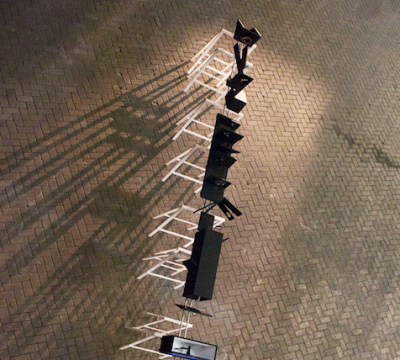mirjam kuitenbouwer
The oeuvre of Mirjam Kuitenbrouwer (Nijmegen, 1967) is centred around the concepts of perception and dwelling. Being connected to what you see, whilst at the same time being irrevocably separate from it, is a recurring theme in her work. In her spatial installations, she plays with perception through duplication, mirroring and shifting perspective. Cameras, lenses, grids, filters and even windows and doors are her instruments.
Mirjam Kuitenbrouwer studied at the Academy for Visual Arts in Arnhem and at the Jan van Eyck Academy in Maastricht. Her work is part of a variety of national and international collections.
Acrobatics for the eye
When you ask artist Mirjam Kuitenbrouwer (1967): ‘Where did it all begin?’, she starts by flicking through a large stack of (small) ring binders, mumbling: ‘I wrote something in here that’s important. Hang on.’ She flicks back, on again, eventually finding the right passage. She reads: ‘The entirety of it is an exercise in discernment, in transparency, logic, plurality and simultaneity.’
If you then ask: ‘What do you mean by that?’, she refers to French author Marguerite Duras and her film India Song in particular. In India Song, a hermetic, exquisite yet exasperatingly pretentious filmic work from 1975, there is a scene featuring a dancing couple in a room with a grand piano. The objects and furniture in the room are infallibly lit, and yet they appear miles away. This is, as the viewer discovers, due to the people in the room facing a mirrored wall. Everything we see is a mere reflection.
Were you to continue your line of questioning, Kuitenbrouwer would say: ‘It also begins with Joëlle Tuerlinckx – with the shadow of a plate I saw at an exhibition in France. That exhibition was generally very important.’
It all seems highly abstract, but upon viewing the latest work, Experience is the Angled Road (after Emily Dickinson), which Kuitenbrouwer displays at the Noletloodsen, all pieces naturally fall into place. Of course Joëlle Tuerlinckx, Belgian ‘queen’ of light and shade, appearance and reality, introspection and perception is a great source of inspiration. And of course the house of mirrors with which Duras mesmerised us and the alienating manner in which she handled the camera in India Song, just as much. Mirjam Kuitenbrouwer has, since her 1991 graduation from the Jan van Eyck Academy in Maastricht, been fascinated by viewing, being viewed, viewing directions, lenses, distortions of perspective and perception. In fact, that fascination with looking is also a fear, dating back to an experience at the experimental kindergarten in Nijmegen she attended as a child. The mirror on the classroom wall, she discovered, was a one-way mirror, through which the children were constantly observed.
Experience is the Angled Road — a quote from an 1864 poem by American recluse and poet Emily Dickinson — is an optical bench of roughly eight metres on wooden trestles. The bench is full of black painted, cell-like structures, lenses, small trapdoors, partitions with circular holes in which mirrors have been suspended that alter the viewing angle in a specific direction. Irritatingly, you can’t quite see inside everything. This makes Kuitenbrouwer’s optical bench somewhat resemble a balance beam, upon which one can injure oneself rather badly during a split jump. Just like that gymnastics bar, the optical bench is a ‘hand wringer’. Nothing happens naturally.
In this linear setup, the balance is not determined by the body, but by the eye. Experience is the Angled Road is an obstacle course in which physical concepts about for instance light fraction and psychological elements combine. ‘Acrobatics’ is what Kuitenbrouwer calls it. The optical bench suggests, through its horizontal character, a chronology which is in fact nonexistent. It is as though, through exploring this bench, one is continually disappointed in one’s desire for perfection and finity.
From a distance, Kuitenbrouwer’s work resembles the light-hearted and cheerful art film Der Lauf der Dinge (1987) by famous Swiss artist duo Fischli & Weiss, but it is essentially different. Der Lauf der Dinge has an inherent chronology to it: nothing goes wrong, everything literally rolls along like clockwork. With Kuitenbrouwer, we are looking at lenses which we — along with the artist — don’t really comprehend. There is no conclusion, only something which occurs.
The occurrence in itself can be perceived as a symbol for life: you want to go straight ahead, but are continually distracted by things around you. There are pitfalls, fences standing in your way, partitions blocking your view. You’re constantly having to find detours: the angled road.
Experience is the Angled Road can also be viewed as an aesthetic piece, with precision to the square millimetre. Kuitenbrouwer displays a hurdling track of mysterious objects on which our eyes get caught. Each object on the beam gets our undevided attention. Eyes dance, hesitate, caress, blink and backtrack. Experience is the Angled Road shows us that that which is incomprehensible can in some strange way be intimately grasped. At least, that is the illusion this extraordinary work creates.


